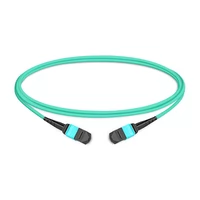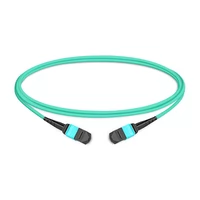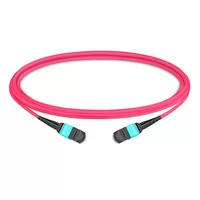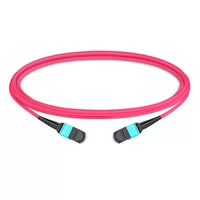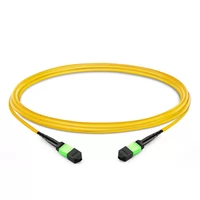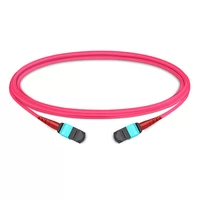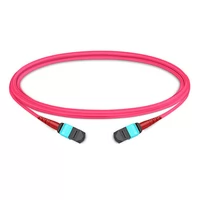Multi-fiber push-on (MTP) cables are essential in fiber optic connectivity and are designed to facilitate and improve data transmission in high-performance networks. With the advancement of technology, there has been an increase in demand for faster, more reliable communication systems, hence making it necessary for professionals to understand MTP thoroughly. This article will look at technical specifications, installation methods, and benefits associated with MTP cables, thereby giving readers a comprehensive view of how these systems work as well as their essential role in modern telecommunication. This guide is meant to provide valuable knowledge about the application and best practices regarding MTP cables, whether you are a network engineer, an IT expert, or just interested in fiber optics technology.
Table of Contents
ToggleWhat is an MTP Cable?
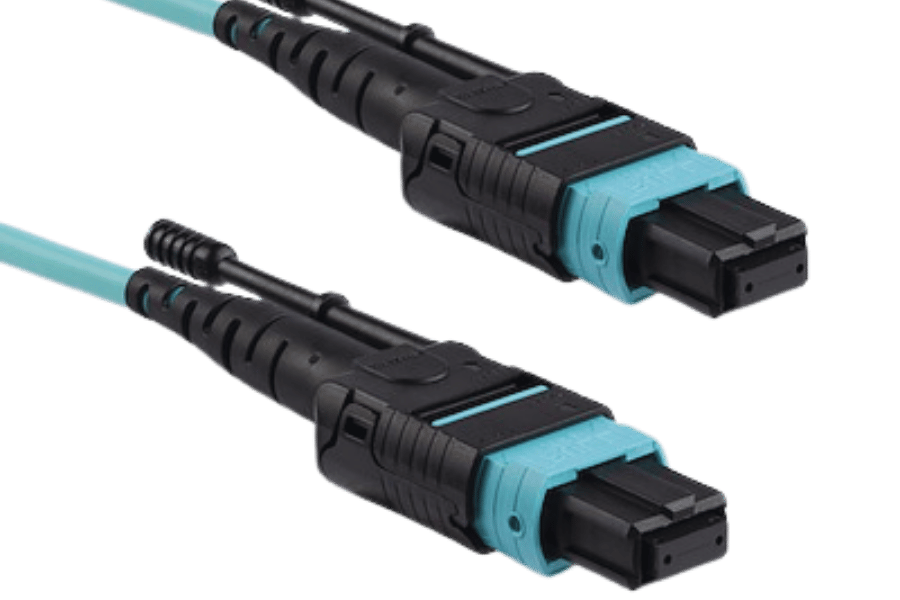
Defining the MTP Cable and Its Uses
Multiple optical fibers are included in a single connector for high-density fiber optic cables, known as MTP cables. Their main purpose is to enable efficient data transfer in large data centers and telecommunications networks. Server interconnections, network backbone connections, and structured cabling systems are just some of the applications they have been designed for. Compared to conventional single fiber cables, MTP cables allow faster deployment and more straightforward scalability which greatly decreases installation time and difficulty while providing better bandwidth support along with more dependable links between devices.
Differences Between MTP and MPO Cables
MTP (Multi-Fiber Termination Push-on) and MPO (Multi-Fiber Push-On) cables are often thought to be the same due to their similar appearances, but several differences exist. MTP cables, invented by US Conec, are designed for better performance and reliability; they have a patented design that allows for more alignment options and higher-density configurations. As far as connector design is concerned, MTP connectors have extra features like reduced insertion loss and more robust locking mechanisms when compared to regular MPO connectors, which may not align very well. In addition, MTP cables come in different configurations, including custom lengths and fiber counts, thereby allowing flexibility in meeting specific network requirements. To summarize the above points, both MTP and MPO cable types play important roles in fiber optic networks. However, MTP wires are preferred for use in high-performance applications since these products have advanced functionalities resulting from superior engineering processes used during their manufacture.
Key Components of an MTP Fiber Optic Cable
Several important parts that help with their performance in telecommunications networks are present in MTP fiber optic cables.
- Optical Fibers: These are the main components of MTP cables which transmit data as light signals. They can be single-mode or multi-mode; single mode is used for long-distance communication, while multi-mode has a larger core diameter and therefore works best over short distances.
- Connector Housing: Made to be tough, the MTP connector housing includes strong materials that can resist environmental stresses. It’s built so it can easily be put together and taken apart again, making maintenance simpler.
- Alignment Mechanisms: To ensure that the connectors line up correctly, MTP connectors use high-tech alignment systems such as guide pins. This is very important because it reduces insertion loss and increases signal quality overall.
- Protection Sleeve: Environmental elements such as moisture and dust damage the optical fibers hence protective sleeves are included in MTP cables to prevent this. Sustaining these fibers’ integrity through time requires protection from physical harm by anything else too though.
- Cable Jacket: An outer cable jacket made of robust substances such as PVC or LSZH (Low Smoke Zero Halogen) provides additional shielding for internal components. These materials improve fire safety by not producing toxic emissions when burned.
- Strength Members: Aramid yarn or fiberglass rods provide support within strength members integrated into the structure of a cable reinforcement system during installation/operation, meaning tensile forces will have no effect on performance levels. The best option is the strongest.
The synergistic interaction between these elements improves what MTP fiber optic cables can do, making them ideal for high-density network environments where top-notch performance and reliability are essential.
How to Choose the Right MTP Connector?
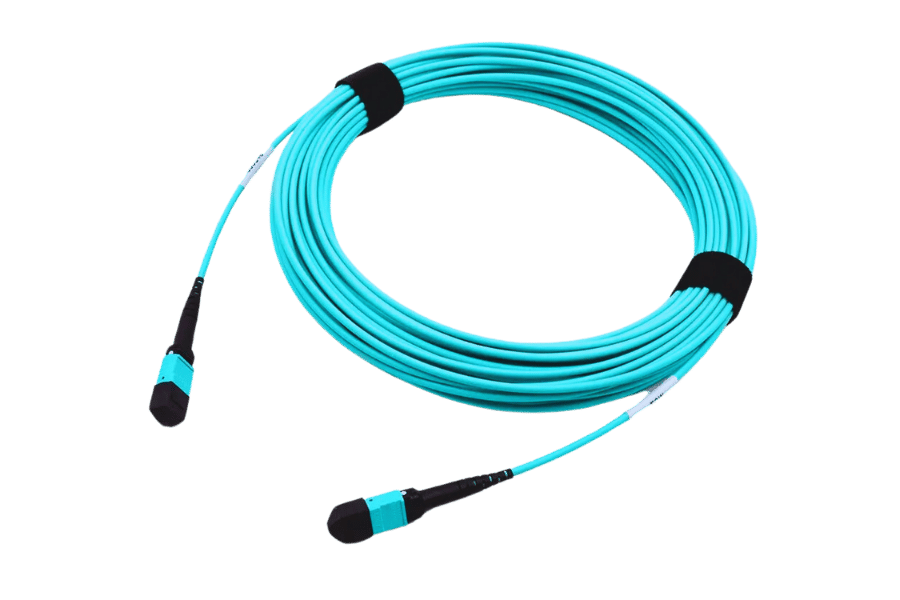
Types of MTP Connectors: APC, MPO, and More
To choose MTP connectors, it is important to distinguish the different types available for specific uses.
- APC (Angled Physical Contact) – These 8-degree angle connectors have minimal back reflection which makes them perfect for tasks that require high accuracy and low signal loss.
- MPO (Multi-fiber Push-On) – These connectors allow multiple fibers to terminate in one connector hence enhancing cable density while minimizing installation time. They are widely used in data centers and telecommunications.
- MTP (Multi-fiber Termination Push-On) – This is an improved version of MPO having better alignment and ability to handle tighter bend radii.
- Standard vs. Custom Configurations—There are standard MTP connectors, but custom configurations can be developed with specified fiber counts and length options to match specific network needs.
Choosing an appropriate type of MTP connector guarantees the best performance and compatibility within a network system.
Considerations for High-Density Environments
In order to optimize performance and maintain reliability when working in high-density environments, there are several important elements that need to be taken into account.
- Space Constraints: Limited physical space is often an issue for high-density layouts. The use of MTP connectors that support optimal fiber counts within compact configurations is critical for maximizing available area.
- Heat Dissipation: Increased cable density can raise temperatures which may impact performance. Proper airflow and cooling mechanisms should be ensured to prevent overheating from occurring.
- Cable Management: Effective cable management solutions are required to prevent tangles and maintain organized pathways. Trays, racks, and labels can facilitate easy access and maintenance.
- Future Scalability: Infrastructure that accommodates changing demands over time must ensure that modular and flexible MTP solutions are chosen so as to allow for potential expansion in fiber count or network capabilities.
These considerations will lead to increased efficiency and longevity of fibre optic systems in high-density situations by network administrators addressing them.
MTP Connectors for Different Fiber Optic Applications
MTP connectors are adaptable solutions used in many fiber optic applications to guarantee the best performance and connection.
- Data Centres: Due to their capacity for high-density deployments and rapid data transmission rates, MTP connectors dominate data centre environments. Because of their modularity, they can be easily configured to work in dynamic networks.
- Telecommunications: In this industry, MTP features are critical backbone infrastructure. It is believed that these types of connections have reliability and versatility, which can support various communication applications while efficiently managing large amounts of traffic.
- Local Area Networks (LANs): These days there has been an increase in the usage of MTP connector configurations within LANs as a means to provide high-speed links between network switches and server racks. The design allows multiple fibers to fit into a smaller space thus maximizing bandwidth where it is most needed.
Organizations should use MTP technology within different application areas so as to improve their network capabilities while ensuring strong performance for future scalability.
What are the Advantages of MTP Fiber Cables?
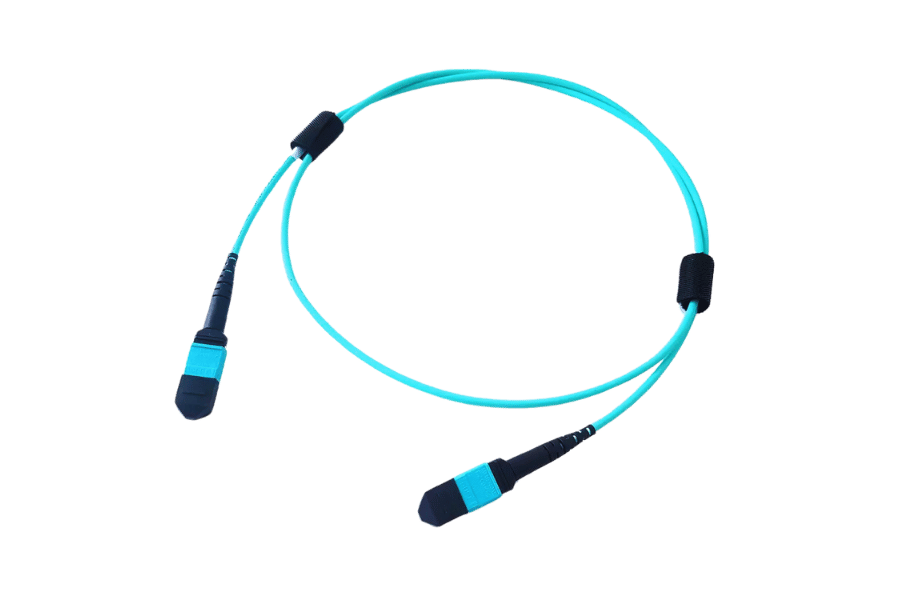
Benefits of Using MTP Fiber in Data Centers
- Space Efficient: MTP fiber cables take up less space while accommodating more fibers, thus promoting efficient utilization of space within data centers.
- Scalable: Its modular construction allows for simple upgrades and expansions that don’t require major alterations in the infrastructure.
- Higher Bandwidth: For modern applications, MTP fibers allow higher data transmission speeds, which are critical to meeting their needs.
- Shortened Installation Time: Pre-terminated MTP assemblies make the installation process easier, reducing downtime and labor costs.
- Easy Management: Cable organization systems with MTP connectors decrease confusion as well as improve maintenance during troubleshooting.
- Better Reliability: The use of these connectors guarantees high-performing signal integrity, leading to fewer interruptions in crucial settings.
Performance Advantages: Low Insertion Loss and High Density
MTP fiber cables, known for their low insertion losses and high density, are perfect for data centers due to their outstanding performance. Low insertion loss is critical because it guarantees that little signal gets diminished while being sent which is important to keep fast data transfers intact and in good quality. This feature improves overall network efficiency allowing longer distances between connections without affecting performance. In addition, MTP fiber cables have a much higher density; thus, they can accommodate many connections in a small physical area, which helps optimize space on racks within data centers. The combination of these two features not only maximizes bandwidth but also makes it scalable and flexible enough to meet the needs of modern-day networking environments.
MTP Cable vs. Traditional Fiber Optic Cable
MTP cables, when compared to traditional fiber optic cables, have a few key differences that highlight the advantages of MTP technology. First of all, MTP cables are multi-fiber connectors which allow for more than one fiber strand to be terminated within a single connector. This provides high-density solutions ideal in environments where there is large cabling but not much room. On the other hand, individual connectors are typically used by conventional optical fibers which leads to greater bulkiness and complexity during installation and management.
Secondly, MTP assemblies are designed for rapid deployment, thus significantly cutting down on the time it takes to install them, as opposed to traditional fiber optic systems. Not only does this efficiency lower labor costs, but it also reduces the chances of mistakes being made during installation processes. Furthermore, better reliability and performance are guaranteed by MTP connectors due to their ability to maintain superior signal integrity coupled with less insertion loss, which is very critical for applications requiring high bandwidth. In summary, though standard fiber optics provide dependability, they do not meet modern networking demands like MTPs do because they are more efficient, space-saving, and scalable.
How to Install and Maintain MTP Cables?
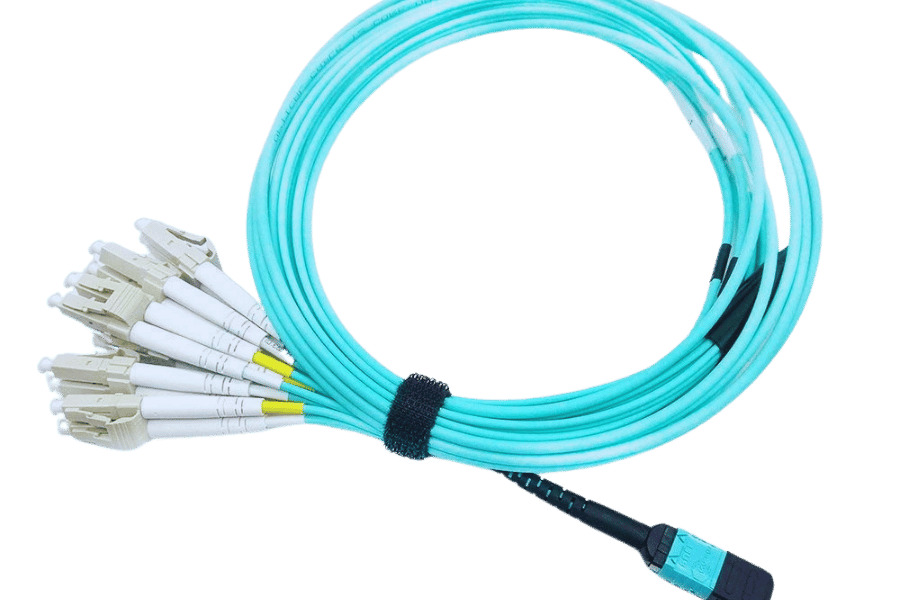
Step-by-Step Guide to MTP Cable Installation
- Preparation: Gather all the tools and materials that are needed for installation, such as MTP cables, connectors, cleaning supplies and termination tools.
- Planning the Layout: Determine the route of installation by taking into account cable lengths, bends and possible obstruction in order to ensure an organized setup that is efficient.
- Routing the Cables: Carefully guide through designated pathways where MTP cables have been laid while ensuring proper bend radius is maintained to avoid sharp angles which may cause signal degradation.
- Connector Termination: Follow manufacturer’s guidelines when terminating MTP connectors while making sure each fiber has been correctly placed inside connector housing before securing it tightly.
- Testing Connections: Use a suitable light source together with power meter for performing optical testing on every connection so as to verify its integrity as well as performance level.
- Labeling: Make clear labels on all cables and connectors to facilitate future maintenance work or troubleshooting processes.
- Documentation: Installation details should be recorded, including cable paths taken during termination points reached where test results were obtained, in order to create accurate system documentation for reference purposes later on.
- Regular Maintenance– Schedule regular inspections and performance tests to keep checking if there is constant reliability of your system.
Common Maintenance Tips for MTP Fiber Optic
- Routine inspections: Regular visual inspections of MTP cables and connectors should be carried out in order to detect any signs of wear, damage or contamination that could affect performance.
- Cleaning protocols: Use suitable cleaning methods and materials specifically made for fiber optic connectors so as to remove dust and debris which are capable of causing signal loss. All connectors must be cleaned before every use.
- Monitoring performance: Optical testing equipment should be used for continuous performance monitoring in order to pick up on any anomalies with the signal quality thus allowing for timely intervention if need be.
- Environmental considerations: The best environmental conditions must be maintained and exposure avoided to extreme temperatures, moisture, or physical stresses that can lead to compromising its integrity.
- Proper storage: When not being used, MTP cables ought to be kept in protective cases/racks so as to prevent them from getting damaged physically/kinking thus prolonging their life span.
- Documentation updates: Maintenance logs should always remain current by recording all inspections done, tests taken and actions performed which leads into a more informed system management approach.
Tools and Accessories Needed for MTP Cable Installation
- MTP Connector and Cable: This is the main installation component. MTP cables come in different configurations and fiber counts to meet specific networking needs.
- MTP Cassette Modules: These are necessary for housing MTP connectors, which provide a convenient termination point in patch panels or enclosures. It is very important to choose the right cassette module type (either LC or SC) based on your cabling infrastructure.
- Fiber Optic Cable Stripper: A special tool designed for stripping outer jackets of fiber optic cables without damaging internal fibers, thus ensuring that they are well prepared before termination.
- Fusion Splicer or Cleaver: When it comes to splicing MTP with other types of fiber, use fusion splicers or precision cleavers so you can get good quality splices while minimizing signal loss.
- Testing Equipment: Use optical testing instruments like Optical Time Domain Reflectometers (OTDRs) and power meters to check if everything works properly after installation and to find any faults within the system.
- Cleaning Kits: To keep connector surfaces clean and ensure high-quality signal transmission, you need a complete cleaning kit containing lint-free wipes, Isopropyl alcohol, and specialized optical fiber cleaning sticks.
- Labeling Materials: For easy identification among members of a fiber optical network, appropriate labeling tools should be used to mark cable ends as well as patch panels.
Using these tools and accessories can simplify the installation process, which in turn leads to an efficient, reliable MTP Fiber Optic Network.
Understanding MTP Cable Standards and Specifications
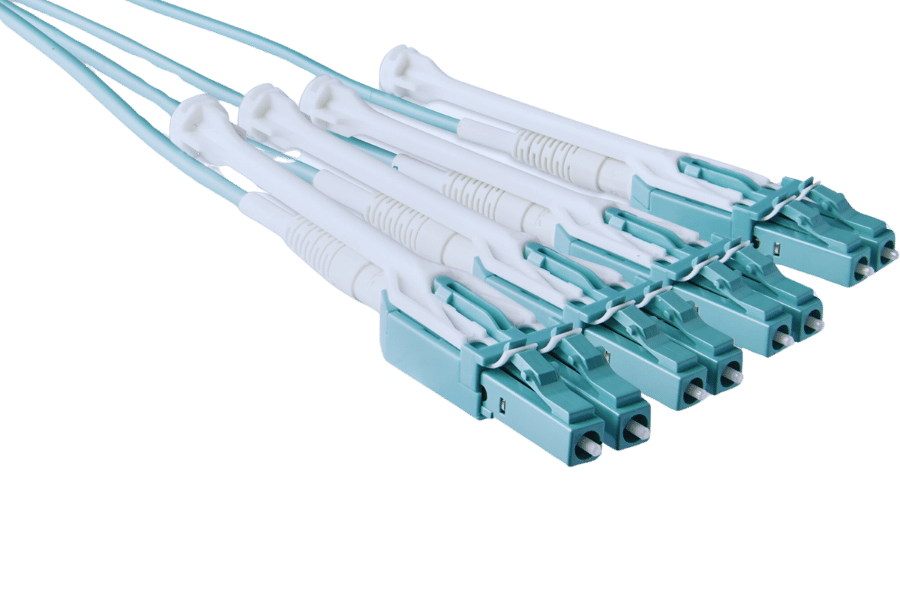
MTP Cable Types: OM3, OM4, and Beyond
- OM3 Cables: OM3 multimode fiber is designed for 10GbE applications, and it has a maximum modal bandwidth of 2000 MHz·km, which supports distances up to 300 meters for the former and 400 meters for the latter.
- OM4 Cables: Unlike OM3, OM4 cables further enhance their performance to support 10GbE distances of 400 meters and 40GbE/100GbE over up to 150 meters with a modal bandwidth of 4700 MHz·km.
- OM5 Cables: Enabling short wavelength division multiplexing (SWDM) applications, OM5 is the most recent multimode fiber standard. It offers a modal bandwidth of 5000 MHz·km and distances up to 200 meters at rates of 100 Gbit/s.
These MTP cable types are very important in optimizing network performance, and they should be chosen based on specific requirements set for each optical fiber installation type.
The Importance of Plenum-Rated MTP Cables
When it comes to installations in air handling spaces where fire codes are strictly enforced, plenum-rated MTP cables carry immense significance. The materials used to construct them emit less smoke and make it harder to catch fire, which helps prevent any potential danger from occurring within these areas. By using MTP cables that have been rated for plenum use, you will be in line with National Fire Protection Association (NFPA) regulations as well as local building codes, ensuring greater safety not just for your installation but also for those who occupy the space around it. These specific types of wires additionally help make networks more reliable since they can endure environmental elements linked to HVAC systems. Therefore choosing such a cable is both a rule you must follow and an essential step toward creating a secure fiber optic network that works efficiently at all times.
Multi-Fiber and Single-Mode Options
When choosing fiber optic cables, it’s important to know the difference between multi-fiber and single-mode cables because they are used for different purposes. Multi-fiber cables use OM3, OM4, and OM5 standards; these cables are built for short-range communication over high bandwidth applications in shorter distances. They have higher modal bandwidths, which make them fit into today’s data-rich environments, especially within data centers. On the other hand, single-mode fibers have a small core diameter, so they can be used for long-distance transmission of information. This type allows lower attenuation rates with high data rates over very large areas, thus suitable for metropolitan area networks (MANs) as well as long-haul telecommunication systems. The decision on whether to use multi-fiber or single-mode depends mostly on what your network requires, such as distance, bandwidth, and application types, among others.
Frequently Asked Questions About MTP Cables
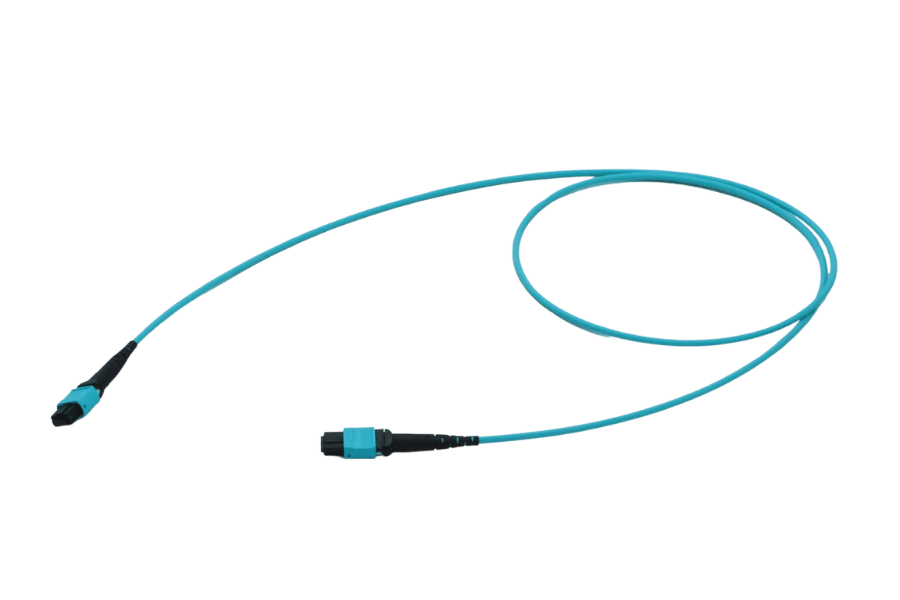
MTP vs MPO: What’s the Difference?
Multi-fiber connector types used in high-density fiber optic installations are MTP (Multi-fiber Termination Push-On) and MPO (Multi-fiber Push-On). Design and performance capabilities differentiate these two connectors. In fact, MTP connectors belong to the broader group of MPO connectors but offer superior optical performance through better alignment accuracy, higher data rate support, and reduced insertion loss, among other things. Moreover, a removable housing and enhanced durability make MTP connectors ideal for use under more challenging conditions. Conversely, while all MTPs are considered MPOS compliant, not every MPO meets mTp specifications.
How to Test and Verify MTP Connections
Testing for integrity and performance of MTP connections should be done with Optical Power Meters and Light Sources or an Optical Time-Domain Reflectometer (OTDR). First, clean all connector ends to keep contaminants from affecting measurements. Next, a light source is connected to one end of the MTP cable, and an optical power meter is connected to the other. Measure the optical power level against system specifications in an acceptable range. For more analysis, use OTDR in order to identify potential faults along fiber paths, like breaks or bends, that can degrade its performance. Record every test result so as to prove conformity with industry standards which will also help when troubleshooting if problems arise.
MTP Fiber Cable Compatibility with Transceivers
For high-density data center applications, MTP fiber cables can be used with a wide range of transceiver types. Most of the modern transceivers utilize 10G, 40G, 100G, and even 400G standards, which can connect well with MTP connectors. Commonly used compatible transceiver modules are SFP+ for 10G connections and QSFP+ or QSFP28 for 40G and 100G connections, respectively. These modules use the MTP connector to create breakout configurations or aggregated connections accommodating several fibers within one connector. It is very important to make sure that the optical specifications of the transceiver match those of the MTP cable being used, especially single-mode vs multi-mode compatibility, as well as suitable wavelength for a particular application. Regular checking of compatibility not only ensures optimal performance but also increases network reliability.
Reference Sources
Frequently Asked Questions (FAQs)
Q: What exactly is an MTP® cable?
A: An MTP® cable, which stands for Multi-Fiber Push-On (MPO), is a high-quality fiber optic wire that connects many fibers in one cable. It is created explicitly for densely packed cabling and easy installation.
Q: How does the 12 fiber MTP® cable work?
A: The twelve-fiber MTP® cable uses a ribbon-style line with twelve parallel strands. This design allows the cable to achieve higher data transfer rates and more efficient network configurations, making it perfect for data centers and high-speed networks.
Q: What’s the difference between MPO and MTP® connectors?
A: MTP® refers to a specific brand of MPO connectors. Therefore, while all MTPs can be classified as MPOS, not every single one will be called so. Compared to other types of connector models, those manufactured by the company called “MPO” feature greater accuracy and performance capabilities, such as lower insertion loss and higher return loss.
Q: Where can you use a 12-strand mtp?
A: A twelve-strand mtp should only be used where there are high-bandwidth requirements, like in telecommunications or data centers, due to its dense cabling properties, which make it ideal for environments that require fast networking equipment connectivity, such as switches, routers, etc.
Q: What is plenum-rated mtp?
A: Plenum-rated mtp means an optical fiber cable approved for use in areas above ceilings or below floors known as air handling spaces (plena). OFNP materials are typically used on these jackets since they have flame-retardant characteristics and low smoke emission when burned.
Q: How is the polarity managed in MTP® connectors?
A: Polarity in MTP® connectors is maintained through specific techniques that guarantee proper alignment and signal transmission between connected devices. Among these techniques are key-up to key-up (Method A), key-up to key-down (Method B), and duplex patch cords that reverse signal paths whenever necessary.
Q: What advantages do MTP ® connectors offer?
A: MTP ® connectors have various benefits, such as denser connections, easier installations, faster deployments, and better mechanical and optical performance compared to traditional fiber connectors. They accommodate up to 24 fibers within one connector, hence improving network effectiveness.
Q: Can MTP cables support 100G networks?
A: Yes, 100G networks can be supported by MTP cables. They are designed for handling high data transfer rates, making them suitable for modern high-speed network environments and data centers needing 100G connections.
Q: What is an MTP female connector?
A: An MTP female connector is a type of fiber optic connector without pins usually connected with guide pin equipped male ones referred to as MPT male combination of male-female ensures proper alignment and secure mating of the fibers.
Q: What is an MTP to LC breakout cable?
A: An MTP to LC breakout cable refers to a kind of MTPLLC fiber optic cable that branches out into individual LC connections. This configuration allows connecting trunk cables from MTPLCPs to equipment with LC ports, thereby allowing for versatility in designing networks compatible with other types.
Related Products:
-
 1m (3ft) 12 Fibers Female to Female Elite MTP Trunk Cable Polarity B LSZH OM3 50/125 Multimode Fiber
$35.00
1m (3ft) 12 Fibers Female to Female Elite MTP Trunk Cable Polarity B LSZH OM3 50/125 Multimode Fiber
$35.00
-
 1m (3ft) 12 Fibers Female to Female Elite MTP Trunk Cable Polarity B Plenum (OFNP) OM3 50/125 Multimode Fiber
$36.00
1m (3ft) 12 Fibers Female to Female Elite MTP Trunk Cable Polarity B Plenum (OFNP) OM3 50/125 Multimode Fiber
$36.00
-
 1m (3ft) 12 Fibers Female to Female Elite MTP Trunk Cable Polarity B LSZH Multimode OM4 50/125
$36.00
1m (3ft) 12 Fibers Female to Female Elite MTP Trunk Cable Polarity B LSZH Multimode OM4 50/125
$36.00
-
 1m (3ft) 12 Fibers Female to Female Elite MTP Trunk Cable Polarity B Plenum (OFNP) Multimode OM4 50/125
$37.00
1m (3ft) 12 Fibers Female to Female Elite MTP Trunk Cable Polarity B Plenum (OFNP) Multimode OM4 50/125
$37.00
-
 1m (3ft) 12 Fibers Female to Female Elite MTP Trunk Cable Polarity B Plenum (OFNP) OS2 9/125 Single Mode
$42.00
1m (3ft) 12 Fibers Female to Female Elite MTP Trunk Cable Polarity B Plenum (OFNP) OS2 9/125 Single Mode
$42.00
-
 1m (3ft) 12 Fibers Female to Female Elite MTP Trunk Cable Polarity B LSZH OS2 9/125 Single Mode
$42.00
1m (3ft) 12 Fibers Female to Female Elite MTP Trunk Cable Polarity B LSZH OS2 9/125 Single Mode
$42.00
-
 1m (3ft) 24 Fibers Female to Female Elite MTP Trunk Cable Polarity A Plenum (OFNP) Multimode OM4 50/125 for 100GBASE-SR10 Connectivity
$63.00
1m (3ft) 24 Fibers Female to Female Elite MTP Trunk Cable Polarity A Plenum (OFNP) Multimode OM4 50/125 for 100GBASE-SR10 Connectivity
$63.00
-
 2m (7ft) 24 Fibers Female to Female Elite MTP Trunk Cable Polarity B Plenum (OFNP) Multimode OM4 50/125μm
$67.00
2m (7ft) 24 Fibers Female to Female Elite MTP Trunk Cable Polarity B Plenum (OFNP) Multimode OM4 50/125μm
$67.00

